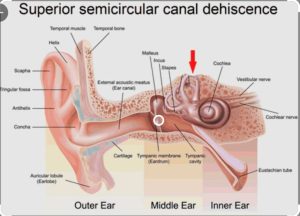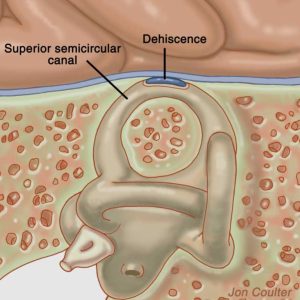Superior Semicircular Canal Dehiscence Syndrome (SCDS)

SCDS is an inner ear condition that causes hearing loss and imbalance. This is due to the absence of part of the temporal bone that covers the superior semicircular canal of the vestibular system which provides our sense of balance. This can result in progressive erosion or physical trauma to the base of the skull, and there is evidence that this defect or susceptibility has a genetic component.
SCDS can affect people in different ways and to various degrees. Symptoms may include autophony (hearing internal noises such as heartbeat and eye movements), dizziness, vertigo (chronic imbalance), Tullio phenomenon (dizziness or imbalance caused by loud sound), conductive hearing loss, aural fullness, pulsatile tinnitus, fatigue, or headache.
Recent research indicates that in approximately 2.5% of the population, the bones of the head only develop to 60-70% of their thickness in the months following birth. This genetic predisposition may explain why the thickness of the temporal bone separating the superior canal from the cranial cavity, which is normally 0.8 mm, is only 0.5 mm thick, making it more fragile and more susceptible to damage resulting from head trauma or slow and progressive erosion. SCDS can be detected by high-resolution computed tomography (HRCT).

Other diagnostic tests include vestibular evoked myogenic potential (VEMP), videonystagmography (VNG), electrocochleography (EcoG), and the rotary chair test. When diagnosed, this temporal bone defect can be repaired by surgically closing the affected bone or using a tamponade of the superior semicircular canal. These techniques are performed by accessing the compromised area through craniotomy of the middle fossa or a transmastoid approach.

